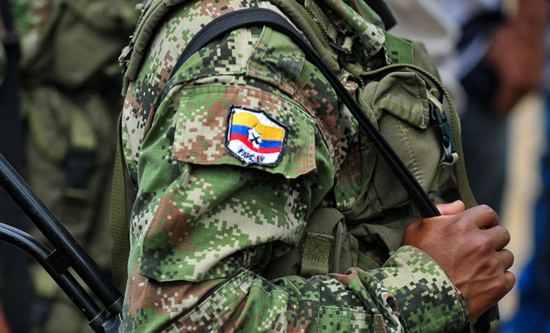
In a further attempt to halt the bloodshed in Colombia the communist-inspired Revolutionary Armed Forces of Colombia (FARC) declared an indefinite cessation of hostilities with the Colombian state on 18 December 2014.
‘We have resolved to declare a unilateral cessation of fire and of hostilities for an indefinite period, which should transform itself into an armistice. … This unilateral ceasefire, which we hope to prolong over time, would end only if it is proven that our guerrilla structures have been the object of attacks from the security forces.’
A month later, on 15 January 2015, President Santos announced that he was prepared to start talks on a bilateral ceasefire ‘as soon as possible’. He has delayed this for the nearly two and half years of negotiations with the FARC, having rejected FARC’s two other recent attempts to strengthen the road to social justice. The most bloodthirsty of the Colombian bourgeoisie have provided cover for Santos as he has slowed negotiations to a crawl. Senator Ernesto Macías, from Former President Álvaro Uribe’s Democratic Centre Party, has called President Santos ‘a puppet of the FARC’.
FARC negotiators welcomed Santos’s announcement, whilst questioning his sincerity as he has continued attacks on the FARC over more than two years of discussions. FARC guerrilla leader Timoleón Jiménez warned that an accord remains far off as Santos aims to demobilise FARC without any examination of the causes of the conflict or the reforms necessary to end it. FARC’s declaration sets the scene for the negotiations which resume on 26 January. It again raises the question of Santos’ refusal to respond to the demands of Colombia’s second largest guerrilla group, the National Liberation Army (ELN), to enter negotiations for the end of the 50-year Colombian civil war.
ELN – fighting since 1964
Peace negotiations in 2002 and 2004 between the rebel group and the previous government of Alvaro Uribe failed. Following meetings from January 2014, the ELN and the Santos government announced talks five days before presidential elections on 10 June 2014. Both parties recognised the contributions of Brazil, Chile, Cuba, Ecuador, Norway and Venezuela in assisting the two parties to this point. However, the ‘agenda’ agreed was very general and it strengthened Santos’s presidential election campaign. No peace talks began and the ELN continue to protest over lack of progress.
ELN commander Eliecer Chamorro (aka Antonio Garcia) explained in January 2015, ‘The government prohibits us from discussing issues related to the National Army, the economy, the state, national sovereignty, the origins of the conflict. There are so many proscriptions that a question arises: what are we even going to talk about? … the government is not in a hurry to make peace a reality, even if it claims otherwise’.
The ELN is still strongest in Colombia’s oil-rich regions and Santos will have to respond if his ambitious plans for the economy are to be fully implemented. Colombia’s economy depends on exports of petroleum, coffee, and cut flowers, and 87% of forced displacement takes place in municipalities which receive royalties from mining and oil production (Comptroller, May 2013). Over 40% of the displaced originally owned some land. From January 1980 to July 2010, internally displaced families had been forced to abandon, sell or turn over more than 6,630,000 hectares. 78.3% of peasant land owners have been left owning only 6.1% of Colombia’s rural land.
Racism
Colombia’s indigenous groups and Afro-Colombians have been disproportionately affected by the land seizures. The UN Office of Coordination of Humanitarian Affairs reports that they made up 73% of displacement victims in 2013. The Centre for Research and Popular Education reports that these groups made up 44% of all new Internally Displaced Persons (IDPs) in 2012. Indigenous people make up over 3.4% of the population but account for more than double this percentage of IDPs. Several indigenous groups are at risk of extinction as a result of the state terror campaign. The majority of these groups now live along the Pacific coast. The swelling of the urban population by rural displacement now means that around one in five mass displacements occurs in urban areas as gangs fight over the drugs trade.
The economy
The Latin American economy as a whole looks likely to grow by less than 2% this year, the worst figure since 2009. However, Colombia will achieve greater rates in the accumulation of capital as it pleases its imperialist backers.
One in every three Colombians lives below the national poverty line and 10.4% of the country’s 47.7 million people on less than $1.25 a day. The income distribution is among the most unequal in Latin America. Santos has also imposed a fiscal rule by which the public sector deficit has been steadily squeezed to less than 1% of GDP per annum. Total public debt is only 33% of GDP. Imperialism is delighted and JP Morgan more than doubled the share of Colombian bonds in its emerging-market indices.
Private-public partnerships in roads and railways aim to raise investment of up to $25bn by 2018. This is essential if the country’s resources are to be fully exploited by capital, but requires the state to somehow to end the armed resistance of the displaced peasantry and their allies. This is why Santos has had to engage in the current drawn out discussions with FARC.
The many groups of US/state promoted fascist butchers that operated before the ‘demobilisation’ of 2003-6 have reappeared, and resumed their attacks on any movement for social justice. It is the steadfast example, activity and demands of the FARC and the ELN and their supporters that give confidence to the poor peasants and workers. This could be seen in the mass demonstrations in the south in summer 2014 against aerial fumigation of coca crops, the Free Trade agreement with the US and oil contracts which steal the wealth of the country from the majority. Hope for the mass of Colombian people lies with such principled resistance against imperialism.
Alvaro Michaels




